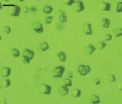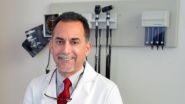(Press-News.org) Opening a new window on the way plants generate the oxygen we breathe, researchers used an X-ray laser at the Department of Energy's (DOE) SLAC National Accelerator Laboratory to simultaneously look at the structure and chemical behavior of a natural catalyst involved in photosynthesis for the first time.
The work, made possible by the ultrafast, ultrabright X-ray pulses at SLAC's Linac Coherent Light Source (LCLS), is a breakthrough in studying atomic-scale transformations in photosynthesis and other biological and industrial processes that depend on catalysts, which efficiently speed up reactions. The research is detailed in a Feb. 14 paper in Science.
"All life that depends on oxygen is dependent on photosynthesis," said Junko Yano, a Lawrence Berkeley National Laboratory chemist and co-leader in the experiment. "If you can learn to do this as nature does it, you can apply the design principles to artificial systems, such as the creation of renewable energy sources. This is opening up the way to really learn a lot about changes going on in the catalytic cycle."
Catalysts are vital to many industrial processes, such as the production of fuels, food, pharmaceuticals and fertilizers, and represent a $12 billion-per-year market in the United States alone. Natural catalysts are also key to the chemistry of life; a major goal of X-ray science is to learn how they function in photosynthesis, which produces energy and oxygen from sunlight and water.
The LCLS experiment focused on Photosystem II, a protein complex in plants, algae and some microbes that carries out the oxygen-producing stage of photosynthesis. This four-step process takes place in a simple catalyst – a cluster of calcium and manganese atoms. In each step, Photosystem II absorbs a photon of sunlight and releases a proton and an electron, which provide the energy to link two water molecules, break them apart and release an oxygen molecule.
Past studies were able to freeze crystals of the catalyst at various stages of the process and see how it looked. But scientists wanted to see the chemistry take place. This was not possible at other X-ray facilities, because the fragile crystals had to be frozen to protect them from radiation damage.
However, the LCLS X-ray laser comes in such brief pulses – measured in quadrillionths of a second – that they could probe the crystals at room temperature in a chemically active state, before any damage set in, and generate data on two of the four steps in oxygen generation.
"We decided to use two X-ray techniques at once at the LCLS: crystallography to look at the overall atomic structure of Photosystem II, and spectroscopy to document the position and flow of electrons in the catalyst," said Vittal Yachandra, a Berkeley Lab chemist and co-leader of the project. "The electrons are important because they are involved in making and breaking bonds and other processes at the heart of chemical reactions."
Another co-leader, SLAC physicist Uwe Bergmann, said, "This result is a critical step in the ultimate goal to watch the full cycle of the splitting of water into oxygen during photosynthesis." The use of both techniques also verified that the molecular structure of the samples is not damaged during measurement with the LCLS, he said. "It's the first time that we have resolved the structure of Photosystem II under conditions in which we know for sure that the machinery that does the water splitting is fully intact."
In future LCLS experiments, the researchers hope to study all the steps carried out by Photosystem II in higher resolution, revealing the full transformation of water molecules into oxygen molecules – considered a key to unlocking the system's potential use in making alternative fuels.
"Getting a few of the critical snapshots of this transition would be the final goal," said Jan Kern, a chemist who holds a joint position at Berkeley Lab and SLAC and is the first author of the paper. "It would really answer all of the questions we have at the moment about how this mechanism works."
INFORMATION:
Besides scientists from Berkeley Lab, SLAC and Stanford University, researchers from Technical University Berlin in Germany, Umea and Stockholm universities in Sweden and the European Synchrotron Radiation Facility in France also participated in the research. This work was supported by the DOE's Office of Science, the National Institutes of Health, the German Research Foundation (DFG), the Alexander von Humbolt Foundation, Umea University, the K&A Wallengberg Foundation, and the Swedish Energy Agency.
LCLS is supported by DOE's Office of Science. SLAC is a multi-program laboratory exploring frontier questions in photon science, astrophysics, particle physics and accelerator research. Located in Menlo Park, California, SLAC is operated by Stanford University for the U.S. Department of Energy Office of Science. To learn more, please visit www.slac.stanford.edu.
DOE's Office of Science is the single largest supporter of basic research in the physical sciences in the United States, and is working to address some of the most pressing challenges of our time. For more information, please visit science.energy.gov.
X-ray laser sees photosynthesis in action
2013-02-15
ELSE PRESS RELEASES FROM THIS DATE:
Combo of Avastin, second drug shows promise fighting brain cancer, Mayo Clinic finds
2013-02-15
JACKSONVILLE, Fla. — The drug bevacizumab, also known by the trade name Avastin, shrinks tumors briefly in patients with an aggressive brain cancer known as glioblastoma multiforme, but then they often grow again and spread throughout the brain for reasons no one previously has understood. Now, Mayo Clinic researchers have found out why this happens. They have also discovered that pairing Avastin with another cancer drug, dasatinib, can stop that lethal spread. Dasatinib is approved for use in several blood cancers.
The findings, based on an animal study, are detailed ...
Scientists develop improved fire management tools for Africa's savannas
2013-02-15
DAKAR, SENEGAL (15 February 2013)—Scientists at the Nairobi-based World Agroforestry Centre (ICRAF) and partners have developed specialized graphs that map out fire behavior, known as nomographs, for landscape managers in Africa's savannas. The study, published in the February issue of the Journal of Arid Environments, pinpoints the optimal conditions for setting early-season prescribed fires—a process that when executed and timed properly, reduces the risk and impact of late dry season bushfires in increasingly fragile ecosystems, both of which are exacerbated by climate ...
Humans and chimps share genetic strategy in battle against pathogens
2013-02-15
A genome-wide analysis searching for evidence of long-lived balancing selection—where the evolutionary process acts not to select the single best adaptation but to maintain genetic variation in a population—has uncovered at least six regions of the genome where humans and chimpanzees share the same combination of genetic variants.
The finding, to be published Feb. 14 in the journal Science, suggests that in these regions, human genetic variation dates back to a common ancestor with chimpanzees millions of years ago, before the species split. It also highlights the importance ...
Smoking bans linked with 'successive reductions' in preterm birth
2013-02-15
The study supports the notion that smoking bans have public health benefits from early life.
It is well established that smoking during pregnancy impairs the growth of an unborn child and shortens gestation. Exposure to second-hand smoke has also been found to affect birth outcomes, yet little is known about the impact of recent smoke-free legislation on birth weight and preterm birth.
So a team of researchers, lead by Dr Tim Nawrot from Hasselt University, investigated whether recent smoking bans in Belgium were followed by changes in preterm delivery. In Belgium, ...
Study finds strong link between income inequality and readmission risk, but not mortality
2013-02-15
The authors estimate nearly 40,000 extra admissions to hospital as a result of income inequality over the three year study period.
Income inequality is associated with a variety of adverse health outcomes, including higher infant mortality, reduced life expectancy, and poorer self-reported health. But little is known about the possible link between income inequality and outcome after admission to acute care hospitals.
So a team of US researchers examined the association between income inequality and risk of death and readmission within 30 days of discharge from hospital. ...
Tough, light and strong: Lessons from nature could lead to the creation of new materials
2013-02-15
In a sweeping review of the field of bio-inspired engineering and biomimicry in the Feb. 15 issue of the journal Science, two engineers at the University of California, San Diego, identify three characteristics of biological materials that they believe engineers would do well to emulate in man-made materials: light weight, toughness and strength.
Joanna McKittrick and Marc Meyers, from the materials science program at the Jacobs School of Engineering at UC San Diego, examine the three characteristics in a wide range of materials, from spider silk, to lobster and abalone ...
Clues to the mysterious origin of cosmic rays
2013-02-15
In the year 1006 a new star was seen in the southern skies and widely recorded around the world. It was many times brighter than the planet Venus and may even have rivaled the brightness of the Moon. It was so bright at maximum that it cast shadows and it was visible during the day. More recently astronomers have identified the site of this supernova and named it SN 1006. They have also found a glowing and expanding ring of material in the southern constellation of Lupus (The Wolf) that constitutes the remains of the vast explosion.
It has long been suspected that such ...
Slithering towards extinction
2013-02-15
NINETEEN PERCENT of the world's reptiles are estimated to be threatened with extinction, states a paper published today by the Zoological Society of London (ZSL) in conjunction with experts from the IUCN Species Survival Commission (SSC).
The study, printed in the journal of Biological Conservation, is the first of its kind summarising the global conservation status of reptiles. More than 200 world renowned experts assessed the extinction risk of 1,500 randomly selected reptiles from across the globe.
Out of the estimated 19% of reptiles threatened with extinction, ...
Losing hope of a good night's sleep is risk factor for suicide
2013-02-15
AUGUSTA, Ga. – When people lose hope that they will ever get another good night's sleep, they become at high risk for suicide, researchers report.
Insomnia and nightmares, which are often confused and may go hand-in-hand, are known risk factors for suicide but just how they contribute was unknown, said Dr. W. Vaughn McCall, Chair of the Medical College of Georgia Department of Psychiatry and Health Behavior at Georgia Regents University.
The new study reaffirms that link and adds the element of hopelessness about sleep that is independent of other types of hopelessness, ...
Climate scientist Schellnhuber to brief UN Security Council
2013-02-15
It will take place on February 15th at the UN headquarters in New York City. Secretary-General Ban Ki-moon plans to attend.
"With unabated greenhouse-gas emissions, humankind would venture into an uncertain future that is much hotter than ever before in its history – so from a scientist's perspective, climate change is a global risk multiplier," says Schellnhuber, director of PIK and chair of the Scientific Advisory Council on Global Change (WBGU) for the German government. Many millions of people could be affected by severe climate change impacts. They range from sea-level ...



